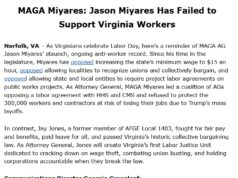Those who would benefit from raising the minimum wage are largely communities of color because current wage inequity particularly disadvantages Black and Latinx workers in Virginia. Compared to 34% of white workers, over 50% of Black and Latinx workers in Virginia are paid low wages. A white worker typically made $23 an hour in 2018, which is $1.40 more per hour than white workers were paid in 2008, after adjusting for inflation. Black workers were paid only $0.95 more per hour in 2018 compared to 2008, and Latinx workers were actually paid less compared to 2008. Given the unequal share of workers of color in low-wage positions, an increase in the minimum wage would provide more equal opportunity to workers of color in Virginia.
Lower wages for workers of color is the result of economic, social, and racial discrimination both in the past and in the present day. For example, the deliberate exclusion of women of color from higher paying jobs until the 1970s has generational effects and is a root cause for the overrepresentation of women of color in low-wage positions in Virginia today. Policies of social and economic exclusion continue to limit opportunities for workers of color, particularly for women of color who will most benefit from the proposed increase in the minimum wage.
Nearly half — 48% — of all Black and Latinx women in the Virginia workforce are expected to benefit from an increase in the minimum wage to $15. This is significant given the large pay gap between women of color and white males — nationally, Black and Latinx women who worked full-time were paid just 61 and 53 cents, respectively, for every dollar that white males were paid in 2017.
One of the primary concerns of an increase in the minimum wage is whether it will lead to losses in employment. Economists have long expressed concern that employers will either lay off workers or reduce the hours of workers to offset their additional costs in wages. However, recent reports have concluded that increases in the minimum wage have little to no effect on employment levels, even for communities of color paid at or below the minimum wage. This is especially good news for Black and Latinx workers who have higher unemployment rates than white workers (particularly in Virginia) and are overrepresented in the population being paid low wages.
The 1967 extension of the Fair Labor and Standards Act (FLSA) provides further evidence that changes to the minimum wage can result in pay increases for people of color without reducing employment levels. The extension of the minimum wage to the agricultural, hotel, restaurant, and other sectors where Black workers represented over a third of the workforce resulted in a reduction of the pay gap between white and Black workers by 20% between the late 1960s and early 1970s.Additionally, this expansion did not have any negative effects on employment levels for Black workers or white workers.
The 1967 FLSA extension has shown that wage policy can be an effective tool to reduce racial inequities. Recent state legislation to raise Virginia’s minimum wage to $15 an hour was rejected. However, the Raise the Wage Act at the federal level is an opportunity to benefit over half a million workers of color in Virginia and prevent further declines in the minimum wage. For workers of color in Virginia, the decision to raise the wage is clear and the time is now.














![[UPDATED with Jim Ryan’s Letter] In Response to Youngkin’s “Sad, Whiny” Letter to Spanberger About UVA, VA Senate Majority Leader Surovell Says He’s “truly embarrassed for Gov Youngkin…After 4 yrs he has no understanding of basic VA govt structure”](https://bluevirginia.us/wp-content/uploads/2025/11/youngkinspanuva3-100x75.jpg)